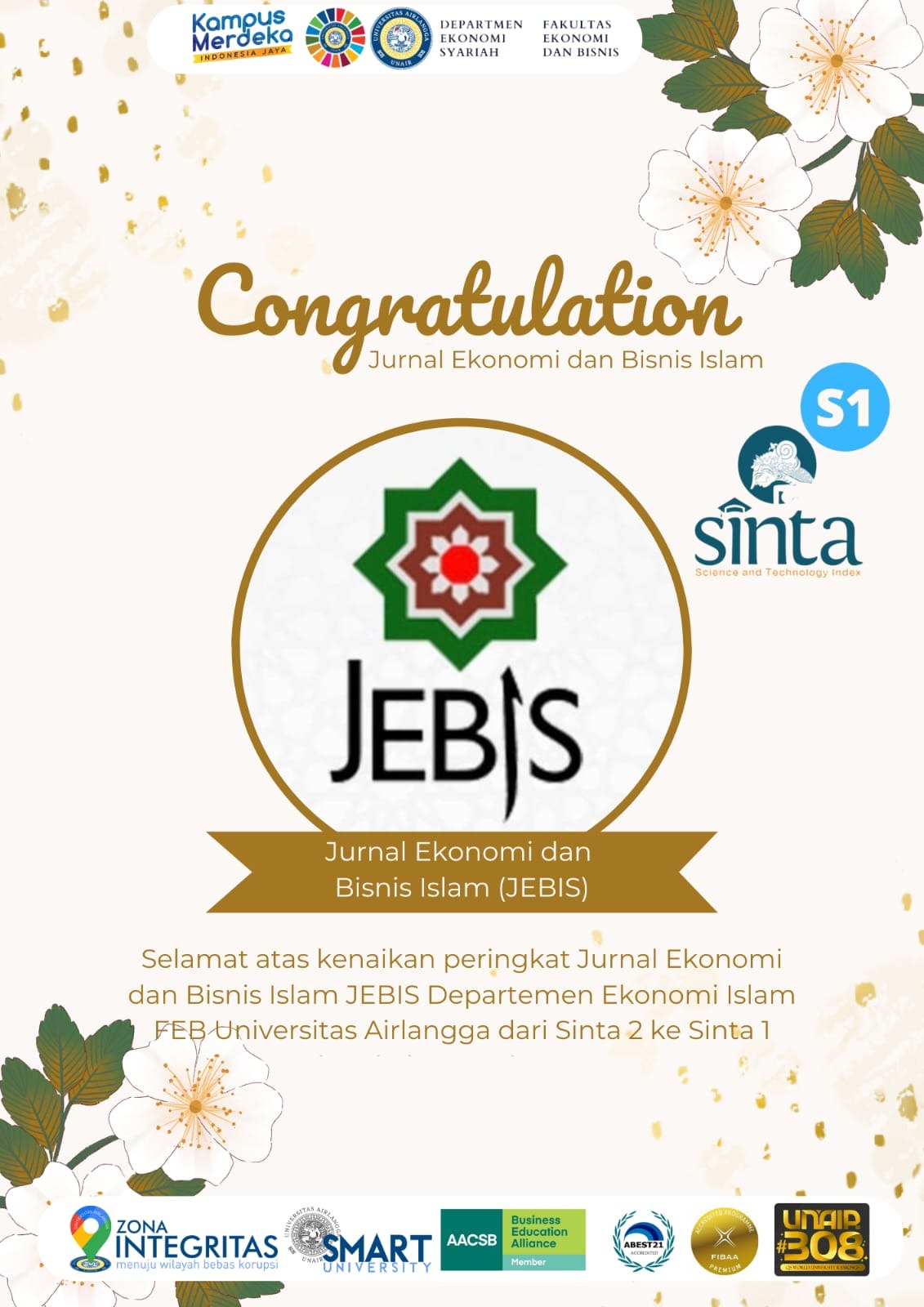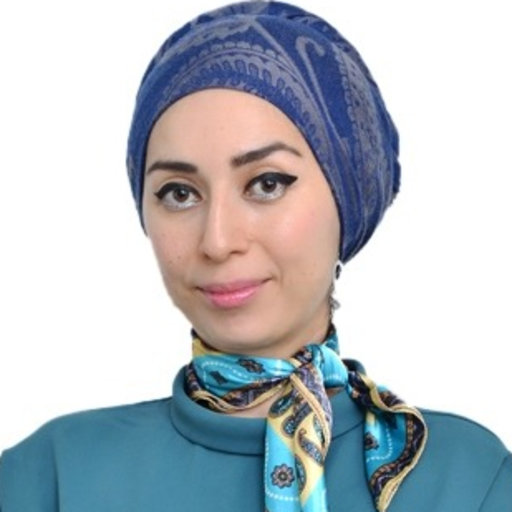ANALYSIS OF FACTORS AFFECTING THE S&P/OIC COMCEC 50 SHARIAH STOCK INDEX
Downloads
Investors and policymakers in Islamic financial markets are expected to comprehend variables impacting the performance of Standard and Poor (S and P)/Organization of Islamic Cooperation (OIC) COMCEC 50 Islamic Stock Index. Therefore, this research aims to analyze the effects of S&P/OIC COMCEC 50 Islamic Stock Index on inflation, West Texas Intermediate (WTI) oil prices, United States Economic Policy Uncertainty (US EPU), and geopolitical risk (GPR). Autoregressive Distributed Lag (ARDL) model is used in the quantitative monthly data analysis spanning 2019-2023. The analysis estimates the adjustment rate toward long-term equilibrium using Error Correction Term (ECT). Furthermore, the short and long term links between global variables and S&P/OIC COMCEC 50 Index are analyzed. The results show that Islamic stock index benefits greatly from WTI oil prices over the long and short terms. Even though inflation and US EPU have no direct effects on the index, GPR shows a strong positive influence over the periods. However, the considerable ECT coefficient points to a quick adjustment process toward long-term equilibrium after external shocks. The significance of oil prices and geopolitical dynamics as major drivers of changes in Islamic financial markets is supported even though US EPU and worldwide inflation have a less significant effect. Based on the description, this research aimed to offer strategic recommendations for Islamic financial markets’ external risk management. Future research should incorporate other macroeconomic factors such as exchange rates, Islamic interest rates, and fiscal stability to understand the durability of Islamic financial index.
REFERENCES
Abdulkarim, F. M., Akinlaso, M. I., Hamid, B. A., & Ali, H. S. (2020). The nexus between oil price and Islamic stock markets in Africa: A wavelet and multivariate-GARCH approach. Borsa Istanbul Review, 20(2), 108–120. https://doi.org/10.1016/j.bir.2019.11.001
Abuzayed, B., & Al-Fayoumi, N. (2021). Impact of oil prices on the Islamic and conventional stock indexes’ performance in Malaysia during the COVID-19 pandemic: Fresh evidence from the wavelet-based approach. Frontiers in Environmental Science. https://doi.org/10.3389/fenrg.2022.962017
Aizsa, A., Magister, P., & Pascasarjana, M. (2020). Pengaruh tingkat suku bunga dan inflasi terhadap harga saham dengan nilai tukar rupiah sebagai variabel intervening pada Jakarta Islamic Index (JII) yang terdaftar di Bursa Efek Indonesia. Jurnal Manajemen Sains dan Organisasi, 1(1). https://doi.org/10.52300/jmso.v1i1.2368
Alam, N., Gupta, L., & Shanmugam, B. (2017). Islamic finance: A practical perspective. Springer.
Al-Thaqeb, S. A., & Algharabali, B. G. (2019). Economic policy uncertainty: A literature review. Journal of Economic Asymmetries, 20(September), e00133. https://doi.org/10.1016/j.jeca.2019.e00133
Bekaert, G., Harvey, C. R., Lundblad, C., & Siegel, S. (2014). Political risk spreads. Journal of International Business Studies, 45(4), 471–493. https://doi.org/10.1057/jibs.2014.4
Bekaert, G., Hoerova, M., & Duca, M. L. (2013). Risk, uncertainty, and monetary policy. Journal of Monetary Economics. https://doi.org/10.1016/j.jmoneco.2013.06.003
Begum, S., M., G., & Bhat, A. A. (2025). Analyzing the Impact of Inflation on the Stock Market Performance: A Comparative Study of Nifty 50 and Sensex. In Studies in Systems, Decision and Control (pp. 413–428). https://doi.org/10.1007/978-3-031-67890-5_38
Badeeb, R. A., & Lean, H. H. (2018). Asymmetric impact of oil price on Islamic sectoral stocks. Energy Economics, 71, 128–139. https://doi.org/10.1016/j.eneco.2017.11.012
Bahloul, S., Mroua, M., & Naifar, N. (2017). The impact of macroeconomic and conventional stock market variables on Islamic index returns under regime switching. Borsa Istanbul Review, 17(1), 62–74. https://doi.org/10.1016/j.bir.2016.09.003
Bekri, R., & Kim, J. H. (2015). Tail risk analysis of the S and P/OIC COMCEC 50 Index. Borsa Istanbul Review, 15(1), 1–16. https://doi.org/10.1016/j.bir.2014.12.001
Bremmer, I., & Keat, P. (2009). The fat tail: The power of political knowledge for strategic investing. Oxford University Press. https://ideas.repec.org/b/oxp/obooks/9780195328554.html
Balli, F., Hasan, M., Ozer-Balli, H., & Gregory-Allen, R. (2021). Why do U.S. uncertainties drive stock market spillovers? International evidence. International Review of Economics and Finance, 76(February 2020), 288–301. https://doi.org/10.1016/j.iref.2021.06.015
Caldara, D., & Iacoviello, M. (2018). Measuring geopolitical risk. Federal Reserve Board International Finance Discussion Papers. https://doi.org/10.17016/IFDP.2018.1222r1
Caldara, D., & Iacoviello, M. (2022). Measuring geopolitical risk. American Economic Review, 112(4). https://doi.org/10.1257/aer.20191823
Deflyanty, S. P. (2023). Pengaruh ketidakpastian kebijakan ekonomi Amerika Serikat, ketidakpastian kebijakan ekonomi Eropa, dan makroekonomi terhadap indeks harga saham syariah 5 negara ASEAN [Master's thesis, UIN Sunan Kalijaga Yogyakarta].
Delle Foglie, A., & Panetta, I. C. (2020). Islamic stock market versus conventional: Are Islamic investing a ‘Safe Haven’ for investors? A systematic literature review. Pacific Basin Finance Journal, 64(September), 101435. https://doi.org/10.1016/j.pacfin.2020.101435
Dharani, M., Hassan, M. K., Rabbani, M. R., & Huq, T. (2022). Does the Covid-19 pandemic affect faith-based investments? Evidence from global sectoral indices. Research in International Business and Finance, 59, 101537. https://doi.org/10.1016/j.ribaf.2021.101537
Djamaluddin, S., Ardoni, R., & Herawati, A. (2020, March 26). Stock price index (CSPI) in Indonesia Stock Exchange (IDX) period 2014–2018. Dijefa, 1(1), 40–53. https://doi.org/10.38035/dijefa.v1i1.205
Djulianto, W., & Nugroho, V. (2022, October 4). Pengaruh ketidakpastian ekonomi terhadap hutang perusahaan di Indonesia. Derema, 17(2), 242–242. https://doi.org/10.19166/derema.v17i2.5888
El-Gamal, M. A. (2006). Islamic finance: Law, economics, and practice. Cambridge University Press.
Erer, D., & Erer, E. (2020, September 25). The impact of US economic policy uncertainty on developing countries under different economic cycles: A nonlinear approach. Emerging Markets Review, 21, 21–35. https://doi.org/10.1108/978-1-80043-095-220201003
Essayem, A., Gormus, S., Guven, M., Erdal, F., & Uygun, U. (2024). The global risk trinity of hydrocarbon economies: Evidence from the method of moments quantile regression. Energy Reports, 12(August), 3412–3421. https://doi.org/10.1016/j.egyr.2024.09.022
Ghani, M., & Ghani, U. (2024). Economic Policy Uncertainty and Emerging Stock Market Volatility. Asia-Pacific Financial Markets, 31(1), 165–181. https://doi.org/10.1007/s10690-023-09410-1
Hadhri, S. (2021). The nexus, downside risk and asset allocation between oil and Islamic stock markets: A cross-country analysis. Energy Economics, 101(May 2020), 105448. https://doi.org/10.1016/j.eneco.2021.105448
Hasan, M. B., Hassan, M. K., & Alhomaidi, A. (2023). How do sectoral Islamic equity markets react to geopolitical risk, economic policy uncertainty, and oil price shocks? Journal of Economic Asymmetries, 28(e00333). https://doi.org/10.1016/j.jeca.2023.e00333
Hsieh, H. C., Boarelli, S., & Vu, T. H. C. (2019). The effects of economic policy uncertainty on outward foreign direct investment. International Review of Economics and Finance, 64(August), 377–392. https://doi.org/10.1016/j.iref.2019.08.004
Hakim, S., & Rashidian, M. (2004). Risk & return of Islamic stock market indexes. Journal of Investing, 13(1), 103–109.
Hassan, M. K., Aliyu, S., & Hussain, M. (2022). A contemporary review of Islamic finance and accounting literature. Singapore Economic Review, 67(1), 7–44. https://doi.org/10.1142/S0217590819420013
Hassan, M. K., Aliyu, S., Saiti, B., & Abdul Halim, Z. (2020). A review of Islamic stock market, growth, and real-estate finance literature. International Journal of Emerging Markets, 16(7), 1259–1290. https://doi.org/10.1108/IJOEM-11-2019-1001
Javaheri, B., Habibi, F., & Amani, R. (2022, September 9). Economic policy uncertainty and the US stock market trading: Non-ARDL evidence. Springer Science+Business Media, 8(1). https://doi.org/10.1186/s43093-022-00150-8
Karolyi, G. A., & Martell, R. (2010). Terrorism and the stock market. International Review of Applied Financial Issues and Economics, 2(1), 285–314.
Kazak, H., Saiti, B., Kılıç, C., Akcan, A. T., & Karataş, A. R. (2024). Impact of Global Risk Factors on the Islamic Stock Market: New Evidence from Wavelet Analysis. In Computational Economics (Issue 0123456789). Springer US. https://doi.org/10.1007/s10614-024-10665-7
Kurniati, I., & Priyanto, A. A. (2022). Pengaruh earning per share (EPS) dan book value per share (BVPS) terhadap harga saham PT Telekomunikasi Indonesia TBK periode 2012–2021. Formosa Journal of Sustainable Research, 1(3), 425–440. https://doi.org/10.55927/fjsr.v1i3.910
Li, X. M., & Peng, L. (2017). US economic policy uncertainty and co-movements between Chinese and US stock markets. Economic Modelling, 61(July 2016), 27–39. https://doi.org/10.1016/j.econmod.2016.11.019
Marashdeh, H., Ashraf, S., & Muhammad, N. (2020). Impact of macroeconomic variables on Islamic and conventional stock market returns: A panel data approach. Global Business and Economics Review, 23(4), 390–411. https://doi.org/10.1504/GBER.2020.110685
Mishra, A. K., et al. (2019). Oil price shocks and Islamic stock markets in the global financial crisis: Evidence from the wavelet coherence approach. Energy Economics, 68, 398–413. https://doi.org/10.1016/j.eneco.2019.01.021
Meo, M. S., Durani, F., Ali, S., Ademokoya, A. A., Nazar, R., & Raza, S. A. (2022). Performance of sectoral Islamic indices during COVID-19. International Journal of Trade and Global Markets, 16(4), 301–326. https://doi.org/10.1504/IJTGM.2021.10040255
Mohamad, M., Yahya, N. D., & Nahar, H. S. (2024). Exploring the Intellectual Structure of Published Islamic Equity Market Research: A Bibliometric Analysis Covering Over Two Decades of Literature Repertoire. Journal of Economic Cooperation and Development, 45(2), 177–208.
Mollah, S., Quoreshi, A. M., & Zafirov, G. (2017). Shari’ah supervision, corporate governance, and performance: Conventional vs. Islamic banks. Journal of Banking & Finance, 78, 210–229.
Ndako, U. B., Salisu, A. A., & Ogunsiji, M. O. (2021, June 29). Geopolitical risk and the return volatility of Islamic stocks in Indonesia and Malaysia: A GARCH-MIDAS approach. Journal of Islamic Finance, 2(3). https://doi.org/10.46557/001c.24843
Prüser, J., & Schlösser, A. (2020). On the Time-Varying Effects of Economic Policy Uncertainty on the US Economy. Oxford Bulletin of Economics and Statistics, 82(5), 1217–1237. https://doi.org/10.1111/obes.12380
Rahman, M., Zaiane, S., & Zied, T. (2021). Risk and return characteristics of Islamic indices: A multi-country study. Emerging Markets Review, 47, 100783.
Siddiqui, K., & Bhatti, M. I. (2020). The impact of oil price shocks on Islamic and conventional stock markets: Evidence from global indices. Energy Economics, 87, 104743.
Sioofy Khoojine, A., Shadabfar, M., & Edrisi Tabriz, Y. (2022). A mutual information-based network autoregressive model for crude oil price forecasting using open-high-low-close prices. Mathematics, 10(17). https://doi.org/10.3390/math10173172
Suhartini, N. (2024). SYI ’ AR IQTISHADI Analisis Faktor-Faktor Yang Mempengaruhi Indeks Saham S & P / OIC COMCEC 50 Shariah Dengan Inflasi Sebagai Variabel Intervening. 8(1), 1–19. https://doi.org/http://dx.doi.org/10.35448/jiec.v8i1.25585
Suhartini, N., & Nurul Awaliah, S. F. (2024). Health Analysis of Private Banks during the Covid-19 Pandemic with the RGEC Approach. Jurnal Ilmu Keuangan Dan Perbankan (JIKA), 13(1), 127–142. https://doi.org/10.34010/jika.v13i1.11300
Suriani, Nasir, M., & Ernawati. (2022). Economic fluctuations and monetary policy on the stock market during the COVID-19 pandemic in Indonesia. E3S Web of Conferences. https://doi.org/10.1051/e3sconf/202234005005
Tsai, I. C. (2017). The source of global stock market risk: A viewpoint of economic policy uncertainty. Economic Modelling, 60, 122–131. https://doi.org/10.1016/j.econmod.2016.09.002
Widiatmojo, A. (2015). The role of geopolitical risk and oil price fluctuations on inflation and capital market performance in Islamic countries. Journal of Islamic Finance and Business, 7(3), 101–115.
Yang, M., Zhang, Q., Yi, A., & Peng, P. (2021). Geopolitical risk and stock market volatility in emerging economies: Evidence from GARCH-MIDAS model. Discrete Dynamics in Nature and Society, 2021. https://doi.org/10.1155/2021/1159358
Yuniarti, D., & Litriani, E. (2017). Pengaruh inflasi dan nilai tukar rupiah terhadap harga saham di sektor industri barang konsumsi pada Indeks Saham Syariah Indonesia (ISSI) tahun 2012–2016. I-Finance: A Research Journal on Islamic Finance, 3(1), 31–52.
Zaighum, I., Aman, A., Sharif, A., & Suleman, M. T. (2021). Do energy prices interact with global Islamic stocks? Fresh insights from quantile ARDL approach. Resources Policy, 72(April), 102068. https://doi.org/10.1016/j.resourpol.2021.102068

This work is licensed under a Creative Commons Attribution-NonCommercial-ShareAlike 4.0 International License.
- Every manuscript submitted to JEBIS must obey to the policy and terms set by Journal of Economics and Business Islamic.
- Publication rights on the contents of manuscript published by JEBIS is owned by JEBIS under consent and approval by the corresponding author(s).
- Full text of electronic publication of manuscripts can be accessed free if used for the purpose of education and research according to copyright regulation.
- Share ” copy and redistribute the material in any medium or format
- Adapt ” remix, transform, and build upon the material
- You must give appropriate credit, provide a link to the license, and indicate if changes were made. You may do so in any reasonable manner, but not in any way that suggests the licensor endorses you or your use.
- You may not use the material for commercial purposes.
- If you remix, transform, or build upon the material, you must distribute your contributions under the same license as the original.
Creative Commons Attribution-NonCommercial-ShareAlike 4.0 International License.





.png)














